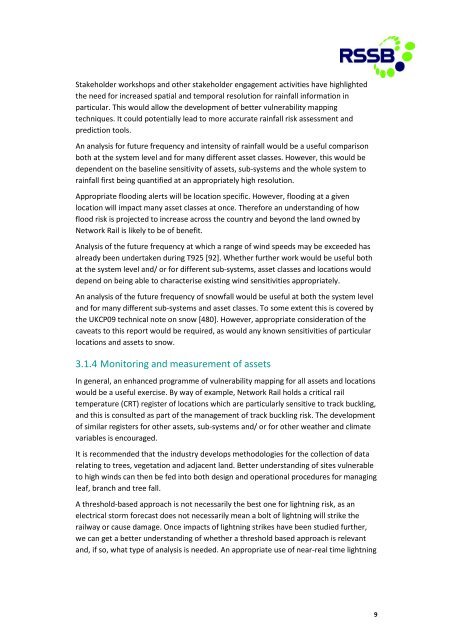Tomorrow's Railway and Climate Change Adaptation Final Report
2016-05-T1009-final-report
2016-05-T1009-final-report
You also want an ePaper? Increase the reach of your titles
YUMPU automatically turns print PDFs into web optimized ePapers that Google loves.
Stakeholder workshops <strong>and</strong> other stakeholder engagement activities have highlighted<br />
the need for increased spatial <strong>and</strong> temporal resolution for rainfall information in<br />
particular. This would allow the development of better vulnerability mapping<br />
techniques. It could potentially lead to more accurate rainfall risk assessment <strong>and</strong><br />
prediction tools.<br />
An analysis for future frequency <strong>and</strong> intensity of rainfall would be a useful comparison<br />
both at the system level <strong>and</strong> for many different asset classes. However, this would be<br />
dependent on the baseline sensitivity of assets, sub-systems <strong>and</strong> the whole system to<br />
rainfall first being quantified at an appropriately high resolution.<br />
Appropriate flooding alerts will be location specific. However, flooding at a given<br />
location will impact many asset classes at once. Therefore an underst<strong>and</strong>ing of how<br />
flood risk is projected to increase across the country <strong>and</strong> beyond the l<strong>and</strong> owned by<br />
Network Rail is likely to be of benefit.<br />
Analysis of the future frequency at which a range of wind speeds may be exceeded has<br />
already been undertaken during T925 [92]. Whether further work would be useful both<br />
at the system level <strong>and</strong>/ or for different sub-systems, asset classes <strong>and</strong> locations would<br />
depend on being able to characterise existing wind sensitivities appropriately.<br />
An analysis of the future frequency of snowfall would be useful at both the system level<br />
<strong>and</strong> for many different sub-systems <strong>and</strong> asset classes. To some extent this is covered by<br />
the UKCP09 technical note on snow [480]. However, appropriate consideration of the<br />
caveats to this report would be required, as would any known sensitivities of particular<br />
locations <strong>and</strong> assets to snow.<br />
3.1.4 Monitoring <strong>and</strong> measurement of assets<br />
In general, an enhanced programme of vulnerability mapping for all assets <strong>and</strong> locations<br />
would be a useful exercise. By way of example, Network Rail holds a critical rail<br />
temperature (CRT) register of locations which are particularly sensitive to track buckling,<br />
<strong>and</strong> this is consulted as part of the management of track buckling risk. The development<br />
of similar registers for other assets, sub-systems <strong>and</strong>/ or for other weather <strong>and</strong> climate<br />
variables is encouraged.<br />
It is recommended that the industry develops methodologies for the collection of data<br />
relating to trees, vegetation <strong>and</strong> adjacent l<strong>and</strong>. Better underst<strong>and</strong>ing of sites vulnerable<br />
to high winds can then be fed into both design <strong>and</strong> operational procedures for managing<br />
leaf, branch <strong>and</strong> tree fall.<br />
A threshold-based approach is not necessarily the best one for lightning risk, as an<br />
electrical storm forecast does not necessarily mean a bolt of lightning will strike the<br />
railway or cause damage. Once impacts of lightning strikes have been studied further,<br />
we can get a better underst<strong>and</strong>ing of whether a threshold based approach is relevant<br />
<strong>and</strong>, if so, what type of analysis is needed. An appropriate use of near-real time lightning<br />
9


